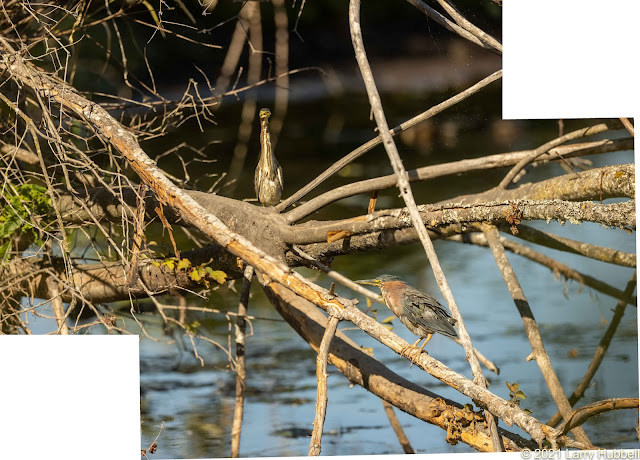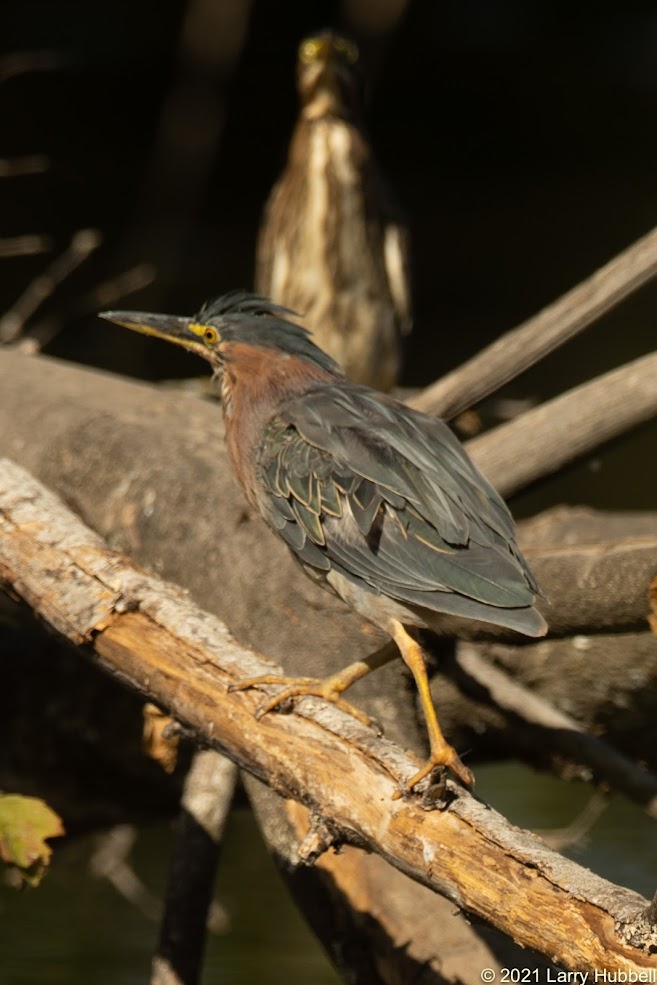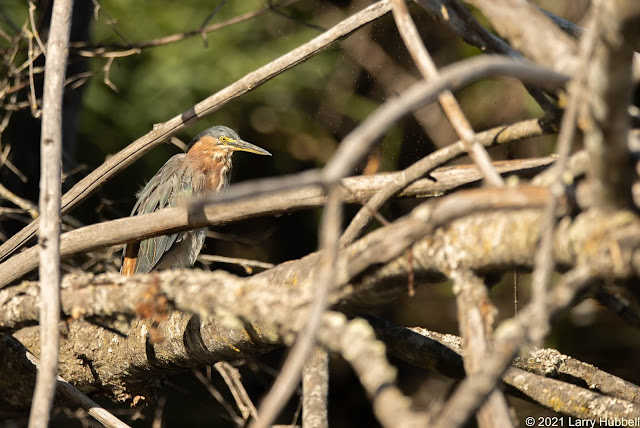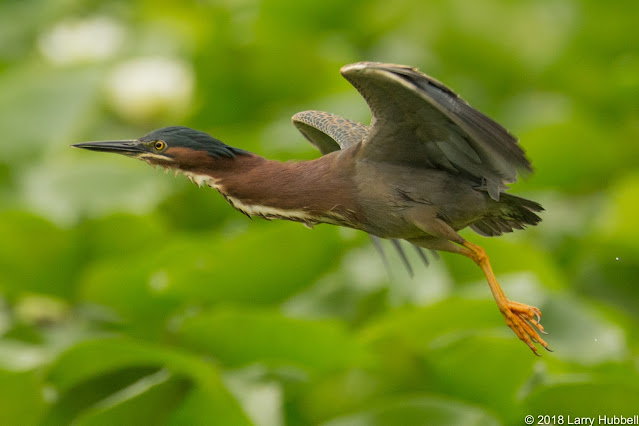Is this a juvenile or an adult Green Heron?
Given the title of this post, I could not resist using this old photo. However, this week's story actually begins with the next photo.
Mature Green Herons are particularly beautiful with their rich, subtle coloring.
When I saw the adult heron land on the branch, I did not immediately realize there was a second one in view.
My camera setup creates a very shallow depth of field. This means with two birds, at different distances, only one can be in focus in a single photo. I am just starting to work with the merge capability in my Lightroom software to learn to address this issue.
I left this composite photo untrimmed to help demonstrate the merge technology.
The heron in the back is a juvenile. From what I have seen, juveniles are usually less dominant than adults. However, since just weeks before they were being fed by their parents, it is not surprising that they sometimes chase after adults begging for food. I wish I could tell whether the adults they chase are really their parents or any available mature, expert hunter of the species.
By September 1st, the adults begin to turn the tables. They start chasing the young. At this point, the young are full-sized, with all of the appropriate equipment, and they really need to learn to find their own food before winter.
In this particular case, there may have been another dynamic in play. The young bird had the higher perch. A bird with a positional advantage can use gravity, like a form of stored energy, to increase its speed when swooping down at a bird in a lower position.
The adult apparently did not like the "threat" being held over its head. It climbed up the branch and chased the younger bird to a lower perch, without ever taking flight.
Notice the generally lighter plumage of the younger bird and the greater amount of yellow on its bill.
Initially, the adult kept an eye on the younger bird. However, to the best of my memory, both birds soon continued on their way without any further aggression. I suspect the adult bird simply wanted to maintain the upper hand, so to speak. It did not seem like it was making a claim to the hunting territory as the younger bird landed quite close by.
The less obvious bird in this photo is the Green Heron. It is sitting on the left end of the log on the left side of the photo. Given that it is significantly smaller than the Great Blue Heron, its survival strategy is much more about fading into the background.
The photo above is another attempt at a composite photo.
The Green Heron flew in first and landed on the log. Before it could start hunting, the Great Blue Heron landed nearby.
Green Herons generally weigh less than a pound. Great Blue Herons can have wingspans of six to seven feet and normally weigh around five pounds. At this point, the Green Heron is already aware of the larger bird and standing more erect than normal, with its neck partially extended.
A moment later the Green Heron went on full alert. The feathers on its head rose and its neck extended further, lifting its head even higher. The Great Blue Heron paced slowly through the water, moving consistently closer to the smaller bird. I have seen Great Blue Herons chase away the smaller competition many times. They certainly seem to be aggressively territorial towards their smaller relatives.
In nature, size generally matters. Especially when the interactions are one-on-one.
Hummingbirds regularly prove that speed can offset the size advantage. Crows demonstrate that total numbers can often outweigh a size advantage. In this case, the Green Heron tried for a moment to act like it was ignoring the larger bird but ultimately failed.
The Green Heron turned tail and flew.
The rich cinnamon-red neck, which is one consistent color all along the side of the neck, the bill which is quite dark, and the golden-yellow legs all indicate its maturity.
Here is a close-up, from a few years back, showing a very similar adult Green Heron. I just noticed that the adults have grey bodies. In the earlier photos, the Green Heron seemed to puff up its grey body feathers as if it was trying to flex and impress the Great Blue Heron with its size.
If we assume that the neck starts where the reddish color begins then we can say that the tail and body combined are shorter than the bird's head and neck, even if we exclude the bill. Heron bodies fit their hunting style and environment very well but they do seem like rather oddly built creatures.
However, their necks are phenomenal multipurpose tools.
Not only do they use their necks to swallow food and turn their heads, just like we do...
...they also use their necks (and bills) to reach out and grab things, scratch their backs, and clean their bodies - similar to how we use our arms and hands.
By the way, here is an example of a juvenile Green Heron. Notice the lighter-colored bill, the lighter-colored legs, the stripes on the side of the neck, and how the stripes extend down onto the body of the bird, into the area that will one day turn solid grey.
Looking back at this photo of a very young, recently-fledged Green Heron it is interesting to notice the bright yellow-orange bill - with almost no darkness on it. This struck me as particularly curious when compared to the yellow bills of Great Blue Herons in the previous post.
The two species are both herons and clearly related with their long bills, long necks, and many shared food sources. The oddity is that the bills of mature Great Blue Herons change to yellow during the breeding season. However, with the Green Herons, their bills are their brightest yellow-orange when they first leave the nest. Later, they turn much darker as the birds mature. How do these essentially opposite color strategies each benefit their respective species?
I was planning to leave the previous sentence as rhetorical. However, the question led me from one thought to another. How do the lives of these species differ? Could the differences explain their color strategies?
Some of the differences include when, where, and how they nest. The Great Blue Herons generally begin breeding just before their second birthday. Green Herons generally begin breeding just before their first birthday. This is not surprising as most smaller birds begin reproduction at the end of their first year. Larger birds often take longer to mature, i.e. Bald Eagles ~5 years, Osprey 2 years, and larger Gulls up to 4 years, etc.
Also, Great Blue Herons generally nest in colonies while Green Herons tend to have solitary nest sites. Given their smaller size and singular nesting habit it would make sense that Green Herons would be more likely to succeed if their nests were well hidden. In a dark nest, a bright reflective bill would presumably be easier for a parent to find. Given that nestlings are totally dependent on their parents for food, it is easy to see how a bright orange-yellow bill might be advantageous for a young Green Heron.
Since Great Blue Herons nest in colonies, with anywhere from a dozen to hundreds of adults (with six-foot-plus wingspans) regularly delivering food, trying to hide their young in dark and hidden locations would be a wasted effort. So it is not surprising that the bills on their young are not nearly so bright.
Another thing I find curious is that a nestling Great Blue Heron has dark blue on its head and white on its face. This is quite similar to the adult in the next photo. However, by the time they are fully-fledged and out in the world, these colors will turn grey. Then, later as the bird matures, the initial colors return.
A mature Great Blue Heron in April.
Great Blue Herons reach full-size rather quickly, but still take almost two full years to become sexually mature. In an earlier post we saw that their plumage changes as they mature but this does appear to be a gradual process. The more abrupt display of a fully yellow bill seems like a very functional indicator of their readiness to reproduce.
A mature Great Blue Heron in October. The need to breed has passed and the yellow has diminished.
These yellow-bill theories seem to fit my available data, however I am always open to alternate possibilities.
As the heron disappeared I wondered if it would be the last one I would see this year.
This November 4th photo of a young Green Heron, who has not yet headed south, is one of the latest in the year that I have seen. You may still find a few around Union Bay but I suspect migration is underway and their numbers are dwindling rapidly. All About Birds has a range map that clearly demonstrates their preference for California in the Winter.
*****************
Mating Schedule Sources:
Great Blue Heron: Click Here and read FAQ #17.
Green Heron: Click Here and read the bottom table under, "How do they reproduce".
*****************
Have a great day on Union Bay...where nature lives in the city and Black Birders are welcome!
Larry
Going Native:
Each of us, who breathe the air and drink the local water, needs to watch and protect our local environment. Native plants and trees encourage the largest diversity of lifeforms because of their long intertwined history with our local environment and native creatures. I have been told that even the microbes in the soil are native to each local landscape. I hope we can inspire ourselves, our neighbors, and local businesses to respect native flora and to support native wildlife at every opportunity. I have learned that our most logical approach to native trees and plants (in order of priority) should be to:
1) Learn and leave established native flora undisturbed.2) Remove invasive species and then wait to see if native plants begin to grow without assistance. (If natives plants start on their own, then these plants or trees are likely the most appropriate flora for the habitat.)3) Scatter seeds from nearby native plants in a similar habitat.4) If you feel you must add a new plant then select a native plant while considering how the plant fits with the specific habitat and understanding the plant's logical place in the normal succession of native plants.
My intention in my weekly post is to include at least one photo each week and visually challenge us to know the difference between native and non-native lifeforms.
Also, Jane Lundin has created a small package, with a lot of critical information that looks quite handy, and light, for backpacking in the mountains in Springtime. It is titled, Mountain Wildflowers of Washington.)
Another idea that integrates perfectly with living in harmony with nature is the concept of Forest Gardening. Apparently, Native Americans collected and nurtured dense multi-layered gardens of native herbs, plants, shrubs, and trees that produced food and herbal medicines. Even after 150 years of no maintenance, the gardens are essentially intact and the diversity of life remains significantly higher than in the surrounding forests. Click Here to learn more.
Which type of fern is this? Is it native to Union Bay?
Scroll down for the answer.
****************
Lady Fern: Yes. It is a native! Click Here to learn more.
*****************
The Email Challenge:
In response, I have set up my own email list. With each post, I will manually send out an announcement. If you would like to be added to my personal email list please send me an email requesting to be added. Something like:
Larry, I want to see more of nature. Please add me to your personal email list.
Thank you for your patience and interest!
My email address is:
LDHubbell@comcast.net
*******************
Final photo:
By the way, both this and the very first photo show juvenile Green Herons. The small white triangles on their sides are an easy mark of youth.

























Thank-you Larry for your amazing pictures and excellent writing about the Green Heron and the Great Blue Heron - two of my favorite birds!
ReplyDelete